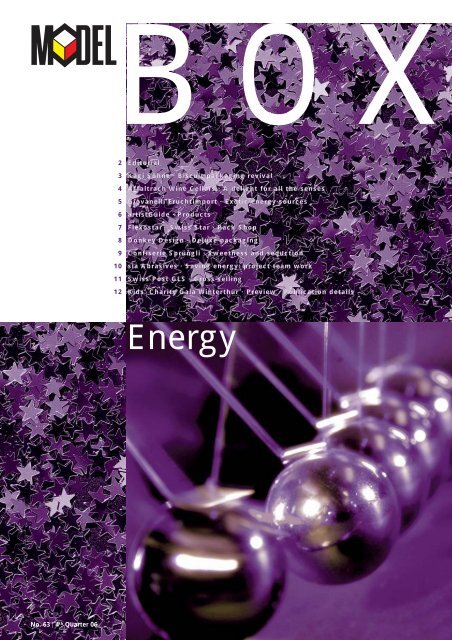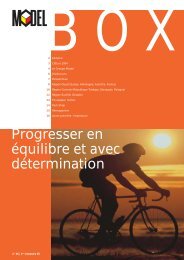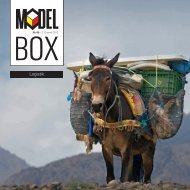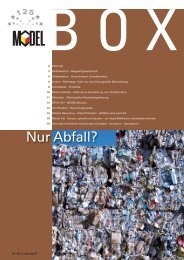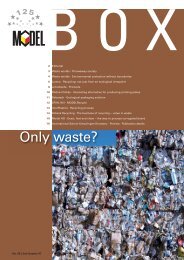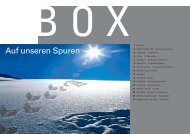Energy - Model Holding AG
Energy - Model Holding AG
Energy - Model Holding AG
You also want an ePaper? Increase the reach of your titles
YUMPU automatically turns print PDFs into web optimized ePapers that Google loves.
BOX<br />
2<br />
3<br />
4<br />
5<br />
6<br />
7<br />
8<br />
9<br />
10<br />
11<br />
12<br />
Editorial<br />
Kägi Söhne · Biscuit packaging revival<br />
Affaltrach Wine Cellars · A delight for all the senses<br />
Giovanelli Fruchtimport · Exotic energy sources<br />
artistGuide · Products<br />
Flexostar · Swiss Star · Pack Shop<br />
Donkey Design · Deluxe packaging<br />
Confiserie Sprüngli · Sweetness and seduction<br />
sia Abrasives · Saving energy: project team work<br />
Swiss Post GLS · Cross-selling<br />
Kids’ Charity Gala Winterthur · Preview · Publication details<br />
<strong>Energy</strong><br />
No. 63 | 4 th Quarter 06
EDITORIAL<br />
Dear Reader<br />
Just as the energy question has been an important<br />
item on the global political agenda for<br />
decades, so the body’s energy balance has become<br />
an important concern in each person’s<br />
life. In terms of language alone there is a fascinating<br />
analogy between the exploitation of oil<br />
and gas reserves built up over millions of years<br />
and the burn-out syndrome of exhausted managers.<br />
Both are instances of living off one’s<br />
capital, and extreme cases of imbalance and<br />
unsustainability. What is energy actually? Perhaps<br />
the following anecdote will help.<br />
One day, indigenous inhabitants on a remote<br />
island see Europeans for the first time who<br />
have arrived in a plane. They watch how these<br />
people pour fuel from a canister into the<br />
plane’s fuel tank and take off again. That<br />
evening they report to the rest of the tribe how<br />
aliens poured a spirit from a container into a<br />
dead metal animal. This spirit revived the animal,<br />
which was then able to move off quickly.<br />
Being so very enlightened, we are quick to<br />
reach for a scientific explanation to set the<br />
naive indigenous islanders right. But it is increasingly<br />
difficult to ignore a feeling of unease<br />
that this materialistic approach is not the whole<br />
truth and that the indigenous inhabitants’ understanding<br />
could be closer to the heart of<br />
the matter than ours. <strong>Energy</strong> as a synonym for<br />
spirit and spirit as a collective metaphor for the<br />
unsolved questions of science?<br />
Be that as it may: in our world of developing<br />
packaging we can indeed confirm that every<br />
new product starts as an idea and, come to<br />
that, the entire process up to the final physical<br />
product is a creative act of transforming spirit<br />
into material.<br />
We also wish that the spirit of good fortune<br />
will imbue the family, the home and our relations<br />
with our customers, suppliers and<br />
friends. In other words, there is no reason to<br />
leave the question of energy and spirit to spiritualists,<br />
mystics and esoteric thinkers!<br />
In this sense and spirit I remain<br />
Your<br />
Daniel <strong>Model</strong><br />
Cover picture: Newton Pendel, www.dfp.ch<br />
2
KÄGI SÖHNE<br />
Biscuit packaging revival<br />
Toggenburg in Switzerland has now<br />
been home to Kägi Söhne <strong>AG</strong> for 70<br />
years. Initially a producer of bakery<br />
and confectionery, the company has<br />
now grown into a medium-sized SME<br />
manufacturing speciality biscuits and<br />
chocolate bars. Many of its processes<br />
are automated. The famous Kägi-fret<br />
and Kägi-fretli products – chocolate<br />
bars covered in the company’s own<br />
chocolate – date back to 1952.<br />
Interview with<br />
Rebecca Willi, a Key<br />
Account Manager with<br />
Kägi Söhne <strong>AG</strong>.<br />
It was in 1958 that you made<br />
your big breakthrough with Kägifret.<br />
What made this such a significant<br />
development?<br />
The combination of chocolate and<br />
superb biscuit products required<br />
a great deal of specialist technical<br />
expertise. But after much experimentation<br />
with recipes and the<br />
installation of a machine to apply the chocolate<br />
coating, we were ready – and the Kägi-fret was<br />
born.<br />
Where are your products available?<br />
Switzerland is still our most important market,<br />
though we are exporting an increasing proportion<br />
of our production. Germany, Austria, the<br />
Middle East and Asia are among our main export<br />
markets.<br />
Don’t the products simply melt away in the<br />
sun?<br />
We make heavy demands on our international<br />
distributors. For example, the storage temperature<br />
has to be maintained exactly – all the way<br />
from our factory to the point of sale in the<br />
hottest countries.<br />
The Kägi brothers sold their life’s work to<br />
the Valora Group in 1996. What effects did<br />
this have on Toggenburg and the workforce?<br />
The takeover had no effects on Toggenburg at<br />
all. In 2001 and 2002 the company spent about<br />
CHF 14 million on modernizing and enlarging<br />
the existing production building. Efficient manufacturing<br />
processes and increased production<br />
capacities are a firm foundation for sustained,<br />
future-oriented growth.<br />
Our low staff turnover rate shows how little<br />
has changed for the workforce. Some of our<br />
employees have been with us for more than<br />
40 years. Their close association with Toggenburg<br />
– and hence with Kägi – is naturally an important<br />
contributory factor. The Valora takeover<br />
made no difference to their love for our products,<br />
their attention to detail or their quality<br />
awareness.<br />
Is it important to develop new products?<br />
Innovation is hugely important in the confectionery<br />
market. In fact it always has been. The<br />
consumer wants variety. We must identify<br />
trends, or – even better – create market momentum<br />
by developing new products ourselves.<br />
This year we launched Kägi-Hazelnut in<br />
Switzerland – the first product in our new line<br />
of biscuits with a chocolate base.<br />
But flavour is not the only field in which we’re<br />
working on new directions. We also constantly<br />
seek out and test new packaging possibilities.<br />
This year you selected a new design for<br />
your products. What do you hope to gain<br />
from this? How has the market reacted to<br />
the change?<br />
Our objective was to create a unified image,<br />
but without abandoning our traditional roots.<br />
The resulting design embodies both tradition<br />
and our association with Toggenburg, but without<br />
looking at all passé. We commissioned a<br />
well-known market-research institute to test<br />
our new packaging on a representative basis.<br />
The results confirm that we are on the right<br />
track. The initial market reaction has been very<br />
positive.<br />
A number of packaging manufacturers were<br />
involved in this redesign. What were the<br />
challenges to them?<br />
Our products are available in several different<br />
packages, not all of which are printed in the<br />
same way. We had to make sure that the<br />
colours look exactly the same on all of them:<br />
the new Kägi shade of red, for example.<br />
Our displays had to be changed as part of the<br />
redesign. We collaborated closely with the<br />
<strong>Model</strong> company on a new display concept that<br />
meets the product presentation requirements<br />
of Sales and Marketing, and also<br />
satisfies logistical needs. The first<br />
new display will be on show in<br />
Swiss retailers from January 2007.<br />
New Design<br />
Packaging from 1958, 1968, 1998, 1999 and 2006<br />
(from bottom to top)<br />
What will you concentrate on in 2007?<br />
We’d like to make our new Kägi-Hazelnut product<br />
even better-known, and strengthen its distribution.<br />
The new point-of-sale displays will<br />
attract a certain amount of attention.<br />
In addition to your demanding professional<br />
activities, you have also taken on teaching<br />
duties as well. Where do you get your<br />
energy from?<br />
I love what I do! I get the energy I need from<br />
my work, the inspiration of my team – and of<br />
course from my great affection for our<br />
products.<br />
Being able to pass on something of my love<br />
for sales and marketing to my pupils, who are<br />
always eager to learn, is a source of great<br />
pleasure to me.<br />
I also spend at least an hour jogging every<br />
evening in the fresh air. That’s when I get<br />
some of my best ideas.<br />
3
AFFALTRACH WINE CELLARS<br />
A delight for all the senses<br />
Now more than 75 years old, the<br />
Schloss Affaltrach wine cellars are<br />
headed by the third generation of Baumanns,<br />
Reinhold and Thomas – under<br />
whose leadership sales have nearly<br />
doubled in the last few years.<br />
Schloss Affaltrach offers a first-class<br />
range of wines, both still and sparkling,<br />
that have won prize after prize.<br />
Thomas Baumann,<br />
you have been successfully<br />
holding<br />
your own against<br />
stiff competition for<br />
many years. What’s<br />
your secret?<br />
Flexibility. We are<br />
flexible at all levels<br />
and in all our processes. As soon as we detect<br />
a market need, we look for a way to meet it –<br />
rapidly and unbureaucratically. We also attach<br />
great importance to giving our customers personal<br />
service.<br />
Around 85% of German sparkling wine comes<br />
from three major producers. We operate in the<br />
smaller segment: the remaining 15%, where<br />
we focus exclusively on niche markets. I’m<br />
convinced that’s where our strength lies: it<br />
gives us a healthy cost/benefit ratio. What we<br />
want isn’t further growth – it’s to produce topquality<br />
wine, and to establish our reputation<br />
among specialist wine retailers and first-class<br />
restaurants.<br />
Our own brands account for around 95% of<br />
the sparkling wine we sell.<br />
What makes you different from other wine<br />
producers?<br />
We pursue a solid added-value strategy for<br />
specialist retailers and the hotel and restaurant<br />
trades. Volume is not a factor.<br />
There are very few producers who make<br />
both still and sparkling wines.<br />
In 1972, after supplying us with grapes<br />
for many years, 69 wine growers established<br />
a cooperative and registered it as<br />
an association. Today it has 250 members,<br />
who between them cultivate<br />
over 200 hectares of vines in Württemberg’s<br />
famous wine-producing<br />
regions. Every grape they harvest<br />
comes to us at Schloss Affaltrach.<br />
We also have vineyards of our<br />
own – about 20 hectares –<br />
that we use for experimentation,<br />
passing the results on to<br />
our growers.<br />
By constantly investing in state-of-the-art<br />
equipment, we ensure optimum quality at<br />
all stages – from harvesting to processing<br />
and ultimately to distribution.<br />
What is the state of today’s wine<br />
market?<br />
Unlike other wine-growing countries in<br />
the EU, unfortunately, consumers in<br />
Germany don’t always appreciate the<br />
wines that are produced in their own<br />
country. On top of that, aggressive pricing and<br />
price dumping – particularly with foreign wines<br />
in the discount segment – are having serious<br />
long-term effects on the buying behaviour of<br />
German consumers.<br />
We combat this by conducting various point-ofsale<br />
campaigns, tastings and the like, in order<br />
to bring our wines to the consumers’ attention.<br />
We also have 50 agents selling our wines on<br />
commission. But whether we sell them direct<br />
or through agents, we always major on the personal<br />
relationship with the customer.<br />
How do you keep the loyalty of your staff,<br />
customers and partners?<br />
It’s my firm belief that you have to manage by<br />
example. But I can’t be an example if I’m just a<br />
manager: I have to be a human being too.<br />
This is true for our customers and staff alike.<br />
Customers see it as very important for me to<br />
look after them personally.<br />
And it’s very important for me to be able to rely<br />
on my staff at all times. They know that I find<br />
time to help them with their problems whenever<br />
I can, whether these be major worries or<br />
minor concerns. Our low staff turnover rate<br />
shows how much they appreciate that. We<br />
feel like members of an extended family: we<br />
are all there when we need each<br />
other.<br />
Can a partner – a packaging manufacturer,<br />
for example – help to optimize your<br />
working processes?<br />
Top-quality products that never give us any<br />
trouble are the alpha and omega of our business.<br />
Boxes, for example, have to be wellmade,<br />
meeting the quality standards we have<br />
set. <strong>Model</strong> never fails to meet our quality requirements.<br />
It has established itself as one of<br />
our regular suppliers, taking the initiative in<br />
suggesting innovations, alternatives and solutions<br />
to problems. An example: we wanted to<br />
switch from a multi-item gift set to a series<br />
that could be used for two, three, four or six<br />
bottles. <strong>Model</strong>, it must be emphasized, was<br />
the only manufacturer to supply a display that<br />
could be used for different bottle sizes. It presents<br />
the bottles on several different levels at<br />
the point of sale.<br />
Autumn is one of your busiest seasons. Can<br />
you take things a little easier at other times<br />
of the year?<br />
Since we make both still and sparkling wines,<br />
we really only have three «quiet» weeks in the<br />
year – in July and August. As soon as the<br />
grape harvest is over and the accounts have<br />
been finalized, I’m out with our customers and<br />
agents again.<br />
What are your priorities in the years to<br />
come?<br />
One of them is my family. I’d like to spend<br />
more time with my wife and three children.<br />
But apart from that, I naturally have a number<br />
of business objectives.<br />
I want to strengthen our position in our existing<br />
niche markets, as well as moving into new<br />
ones. We have an enormous, diverse range of<br />
products, which certainly needs thinning out<br />
over the next few years. Some of our<br />
processes are in need of optimization.<br />
On the other hand, we must go on modernizing<br />
in order to become even more flexible. As<br />
long as we can keep our feet on the ground,<br />
that is.<br />
4
GIOVANELLI FRUCHTIMPORT<br />
Exotic energy sources<br />
Interview with Sergio Giovanelli<br />
Giovanelli Fruchtimport <strong>AG</strong> is a specialist<br />
importer and seller of fruit, vegetables<br />
and mushrooms. The company<br />
started small 75 years ago, selling citrus<br />
fruit from Italy from horse-drawn<br />
carts. When Bruno Giovanelli took over<br />
at the helm in the 1960s, its<br />
product range became more<br />
and more international.<br />
The first new lines<br />
were chanterelle<br />
mushrooms from<br />
Poland and asparagus<br />
from California.<br />
The company<br />
also operated a retail<br />
outlet in Frauenfeld, which<br />
has now grown into a company with<br />
56 employees. Today it buys produce<br />
from all over the world and distributes<br />
it throughout Switzerland.<br />
Most produce is transported by air, then<br />
brought to optimum ripeness in the Giovanelli<br />
<strong>AG</strong> ripening chambers in Frauenfeld. «The vitamin<br />
content of the fruit is almost exactly the<br />
same as it was when it was picked», says Sergio<br />
Giovanelli. But the fruit still tastes «different»,<br />
and this is due to a number of factors.<br />
Take the mango, for example – India’s national<br />
fruit. There are more than a hundred different<br />
varieties, but only very few of them can stand<br />
up to the rigours of a long journey. Emotion<br />
probably has something to do with it as well.<br />
Eating an exotic fruit in its natural surroundings,<br />
breathing its air and warmed by its sunshine,<br />
must give it a slightly different flavour.<br />
Giovanelli’s customers include major distributors<br />
and wholesalers supplying the catering<br />
and retail sectors. Its berries, asparagus, mushrooms<br />
and a huge range of exotic fruit are<br />
available 365 days a year. Ultimately it’s the<br />
consumer who decides what he wants, and<br />
what he wishes to do for the environment. Sergio<br />
Giovanelli compares consumer attitudes to<br />
those of tourists. Why go all the way<br />
to Paris to climb the Eiffel Tower<br />
when we have plenty of towers<br />
in Switzerland? What’s the<br />
point of flying to the<br />
Caribbean, with its fabulous<br />
beaches and crystal-clear water,<br />
when we have lakes to<br />
swim in at home? Not a lot of people<br />
know that many of our native<br />
fruit varieties came to us as exotic foreigners.<br />
The pear, for example: every Swiss<br />
consumes an average of nearly seven kilos of<br />
pears a year, but most of us don’t know that<br />
the pear tree originally came from China.<br />
Fruit is not a medicine, but it is full of vitamins<br />
and very healthy. It makes an important contribution<br />
to healthy eating. And because its appearance<br />
matters just as much as content and<br />
flavour, Sergio Giovanelli attaches great importance<br />
to the packaging of his produce – making<br />
every effort to ensure that the wrapping reflects<br />
the quality of what’s inside<br />
it. This is why the<br />
fruit is taken out of the<br />
bulk containers in<br />
which it is delivered,<br />
and repackaged in small<br />
quantities as each customer<br />
requires.<br />
Today there is a clear trend<br />
away from meat and towards<br />
mushrooms, and this is having<br />
perceptible effects on the Giovanelli<br />
range of produce.<br />
But leaving trends aside, Sergio Giovanelli is<br />
convinced that the movement towards healthy<br />
snacks for children in kindergarten (no sweets<br />
or chocolate) is very positive. He hopes it will<br />
spread to other schools as well. After all, fruit<br />
is the ultimate fast food.<br />
Led by Romeo and Sergio Giovanelli, the company<br />
now sells rich sources of vitamins whatever<br />
the season – though the supplier countries<br />
follow the natural cultivation cycle. So although<br />
strawberries, for example, are imported<br />
from the four corners of the world, locally-produced<br />
fruit takes precedence when it’s in season.<br />
It is simply not possible to meet the requirements<br />
of the market by offering only local<br />
fruit and vegetables.<br />
Exotic fruit isn’t always properly marketed,<br />
more’s the pity. Giovanelli <strong>AG</strong> is determined<br />
not to make that mistake: it takes an active role<br />
in the market, educating its customers and<br />
consumers. It shows them<br />
the best ways of preparing<br />
and presenting fruit, helping<br />
them to enrich their diet by<br />
adding diversity to it.<br />
Giovanelli’s suppliers must undergo specialist<br />
testing and achieve prescribed quality standards.<br />
For example, no produce is obtained<br />
from suppliers who employ child labour or fail<br />
to pay a fair wage.<br />
5
ARTISTGUIDE<br />
Products<br />
Tumbler tray<br />
Carrying several tumblers through a<br />
large crowd of people is always a challenge.<br />
The Atelier V. graphic design studio asked<br />
<strong>Model</strong> to design a tray for four tumblers, each<br />
containing 30–50 cc. As well as being stable,<br />
the tray also had to be useless for throwing –<br />
to stop it from being used as a missile if things<br />
got out of hand. It is currently in successful use<br />
at a variety of events.<br />
Gift with a cardboard bow<br />
Hiestand is presenting its customers with a<br />
very special Christmas gift this year. Its packaging<br />
must be attractive yet surprising, and it has<br />
to be suitable for distribution by post. The special<br />
twist-fastening means that no extra ribbon<br />
bow is required. The fastening conceals a fondue<br />
set, which is naturally equally perfect for<br />
Hiestand pastries.<br />
The packaging is<br />
double-corrugated,<br />
which makes it particularly<br />
robust.<br />
A gift box that doubles as<br />
protective packaging<br />
Smoked salmon, caviar<br />
and sparkling wine<br />
are an ever-popular<br />
Christmas gift,<br />
and this presentation<br />
box accommodates<br />
all three. Not<br />
only that: it also doubles as protective<br />
transport packaging.<br />
The product recesses are readily adjustable,<br />
so the box can hold items of several<br />
different sizes.<br />
This packaging highlights how closely the<br />
various <strong>Model</strong> facilities work together: it was<br />
developed in Weinfelden and manufactured in<br />
Flamatt.<br />
Toblerone «One by One Mix Box»<br />
Kraft Foods Schweiz <strong>AG</strong> and <strong>Model</strong> PrimePac<br />
are launching a new octagonal Toblerone<br />
package. The Christmassy<br />
design,<br />
with its gleaming<br />
gold stars, is<br />
calculated to<br />
put the consumer<br />
in the<br />
mood for the festive<br />
season. The lid<br />
is printed in six colours,<br />
while the mountain peak, logo and<br />
stars are hot-foil stamped. The peak of the<br />
Matterhorn, the logo and the chocolate tips are<br />
embossed for additional emphasis.<br />
The colourful package contains individual Toblerone<br />
triangles in five different flavours –<br />
which is why the product is called the «One by<br />
One Mix Box». When the package is opened,<br />
the base unfolds into a practical presentation<br />
dish that reinforces the sharing effect.<br />
Core business<br />
partners<br />
«RBA Service in a nutshell:<br />
partnering your<br />
core business» is how<br />
the company summed up<br />
its philosophy at this<br />
year's Finance Forum,<br />
visually underpinning this<br />
with the macadamia nut.<br />
Inside the larger hinged box<br />
made of 300 g/m 2 Magno<br />
Pearl is a foam insert holding a<br />
nutcracker and indigenous<br />
Australian nuts.<br />
The smaller of the hinged lid boxes<br />
contains a solitary nut embedded<br />
in foam.<br />
<strong>Model</strong> InoPac produced,<br />
assembled and<br />
filled the two boxes.<br />
PRIVOR – 3 rd pillar pension<br />
insurance<br />
RBA Service, a subsidiary of RBA<br />
<strong>Holding</strong>, is the regional banks’ services<br />
centre. Clientis Banks mandated RBA<br />
Service to realize this year’s PRIVOR<br />
marketing campaign under the motto<br />
«Time is passing». In addition to the print<br />
media, decorative pillars were erected in all<br />
service counter areas. Each of these stable<br />
offset printed pillars is 1.8 metres high and has<br />
a clock built in.<br />
The challenge facing<br />
<strong>Model</strong> was to produce the<br />
relatively small number of<br />
customized pillars without<br />
incurring huge costs on<br />
die-cutting tools. The solution<br />
was to adapt tools already<br />
available using simple<br />
auxiliary equipment<br />
and so effectively laminate<br />
the round blanks. The<br />
customer was impressed<br />
with the unconventional<br />
yet efficient way the assignment<br />
was handled.<br />
6
FLEXOSTAR · SWISS STAR · PACK SHOP<br />
WEGA 2006<br />
After a brief absence, the Pack Shop returned<br />
to the traditional WEGA trade fair in<br />
Weinfelden this year.<br />
Flexostar – <strong>Model</strong> earns Gold<br />
Once a year the world of flexo printing in<br />
France gets together for the annual meeting<br />
of the ATF (Association Technique de la Flexographie).<br />
This year’s venue was the Eiffel<br />
Tower in Paris.<br />
At the end of the event, which focused exclusively<br />
on the industry’s customers, the ATF<br />
Flexostar awards were presented for the best<br />
prints. The 23 categories covered a wide spectrum<br />
ranging from embedded labels, through<br />
polyethylene tube packaging, to post print corrugated<br />
board.<br />
Four of these categories were open to corrugated<br />
board. <strong>Model</strong> Moudon received the<br />
Golden Flexostar for an outstanding print in the<br />
category Post Print Corrugated Board uncoated,<br />
with screen: Tribal, a wrapping for the<br />
«Cave du Tunnel» company. This wine pack<br />
underscores the value and significance of<br />
South African wines marketed in Switzerland.<br />
This design was printed on uncoated B-flute<br />
corrugated board with a screen of 26 lines/cm.<br />
Thanks to the use of only a small amount of<br />
ink, and the corrections of the printing plate<br />
supplier, which has worked closely with<br />
<strong>Model</strong> for many years, <strong>Model</strong> was able to<br />
reduce the wave effect typical for this<br />
type of printing. Many thanks to everybody<br />
who contributed to our success.<br />
Swiss Star 2006<br />
The Swiss Star in the sales aid/display category<br />
was awarded to the compact Toblerone display.<br />
Though it looks slim, the display has space for<br />
60 400 gram Toblerone units. The individual<br />
trays are attached to the rear edge of the display<br />
by a suspension system, and the attachment<br />
column is in the instantly recognizable<br />
Toblerone shape.<br />
The trays are mounted at a slight angle, which<br />
makes the Toblerone bars look as if they were<br />
constantly being bought and replenished. It’s a<br />
simple matter to remove the trays and replace<br />
them with new ones. Once the sales campaign<br />
is over, the trays are returned<br />
to the normal<br />
sales shelves: the<br />
same trays are used for<br />
both. This was a requirement<br />
stipulated by<br />
Kraft Foods when it<br />
commissioned the new<br />
display.<br />
This display is so successful<br />
that collectors<br />
are actually setting it up<br />
in their living rooms.<br />
The many items displayed on its stand were<br />
particularly well received by visitors to the<br />
event, and this has brought about a sustained<br />
increase in awareness of the Pack<br />
Shop among the regional population. A number<br />
of new products were presented, and<br />
several promising new contacts were established<br />
– a particularly encouraging development.<br />
The Pack Shop competition aroused great interest:<br />
visitors flocked to enter. These were<br />
the lucky winners:<br />
First prize: Elsbeth Geuggis, Wigoltingen –<br />
a 100-franc SBB travel voucher<br />
Second prize: Beatrice Lehn, Märstetten –<br />
a 50-franc Pack Shop gift voucher<br />
Third prize: Giorgio Barilli, Kreuzlingen –<br />
a 30-franc Pack Shop gift voucher<br />
Martin Herbst, Pack Shop Weinfelden with<br />
the lucky winner Elsbeth Geuggis<br />
7
DONKEY DESIGN<br />
Deluxe packaging<br />
The Donkey Design agency specializes<br />
in packaging design for all types of<br />
cosmetic products. This includes<br />
repackaging and graphics as well as<br />
designing forms for receptacles and<br />
flacons.<br />
The goal is to develop creative, holistic<br />
concepts for each design task that fulfil<br />
the requirements of the brand and<br />
its environment and give the product<br />
the best possible appearance.<br />
Ms Brandt, what<br />
fascinates you about<br />
luxury packaging,<br />
and when do you regard<br />
it as a success?<br />
What particularly appeals<br />
to me about luxury<br />
packaging is the<br />
challenge of turning<br />
unpacking into an experience,<br />
when opening<br />
the outer wrapping<br />
reveals an inner<br />
life that, in turn, is another stage on the path of<br />
discovery that leads to innermost element, the<br />
product itself.<br />
In my opinion, all successful luxury good packaging<br />
uses means that give the surface a beautifully<br />
refined finish, such as hot foil stamping,<br />
surface contrasts such as matt finish and<br />
glossy varnish, lustre and metallic effects, blind<br />
stamps and interesting colour combinations.<br />
Depending on the choice, the resultant packaging<br />
can be either opulent, or simple and puristic.<br />
This depends entirely on the brand image.<br />
The design should be individual and its appearance<br />
should, as far as possible, be unmistakable.<br />
For me it is always important to exploit<br />
the technical possibilities of production to the<br />
full, to use high-quality surface refinements to<br />
add an extra dimension to the graphics and<br />
colouring.<br />
You helped to design several cosmetic<br />
packagings with <strong>Model</strong> Kramp. What is the<br />
focus of this collaboration?<br />
I like working with <strong>Model</strong> Kramp a lot. For instance,<br />
we developed the women’s fragrance<br />
Boss Intense and Twin Duft for Marc O’Polo<br />
in common. Together we were able to develop<br />
a very nice promotional product for Luxe Pack<br />
2005.<br />
I like the fresh commitment, the enthusiasm<br />
for finding solutions to even very complex challenges<br />
and the professional approach to work.<br />
The consumer sees «only»<br />
the beautiful packaging,<br />
which unfortunately all too<br />
often ends up in the<br />
wastepaper basket. Despite<br />
this, the market still places a<br />
huge premium on successful<br />
packaging. How do you<br />
explain this?<br />
In the market place, the packaging is the consumer’s<br />
first contact with the product. This<br />
packaging must awaken desire. In the luxury<br />
good segment in particular, desire is an essential<br />
ingredient in motivating people to buy.<br />
How do you test market acceptance of a<br />
new product?<br />
Our clients often commission tests and surveys<br />
from market research institutes. If they<br />
ask us to do so, we also take charge of the<br />
arrangements. Before we present our designs<br />
to our clients, we discuss possible associations<br />
and immediate messages internally in the<br />
agency with various colleagues, some involved<br />
in the project, others not.<br />
Have you detected any new trends at Luxe<br />
Pack?<br />
The great thing about Luxe Pack is, I think, the<br />
enormous variety of products and, hence, the<br />
range of extremely diverse types of product<br />
images; these cannot be reduced to a single<br />
trend. All in all, though, it seems to me that<br />
there is again a greater preference for matt<br />
structured cardboard.<br />
Why do you as designer take part in Luxe<br />
Pack?<br />
Luxe Pack gives a very concentrated impression<br />
of new market developments in diverse<br />
fields. There is always the chance that the exhibitors<br />
and their new developments, whether<br />
printing, paper, plastic or glass, will provide<br />
fresh impetus and stimulation for your own<br />
creative processes. Furthermore, beautiful design<br />
is one thing, but I realize time and again<br />
how important it is to be informed about new<br />
technical possibilities in production so as to<br />
take them into account when realizing one’s<br />
own designs. In the end, this is what you need<br />
to bring a really successful product that is perfect<br />
down to the smallest detail to market.<br />
The <strong>Model</strong> Kramp/<strong>Model</strong> PrimePac stand presented<br />
a good overview of achievements and<br />
developments.<br />
How do you go about producing a new<br />
design?<br />
First, it is important to be properly informed<br />
about the brand you are creating the design for<br />
and its background. Another important aspect<br />
you have to take into account is what distinguishes<br />
the brand from the competition. And<br />
then there is the individual product concept<br />
that provides the framework in which you can<br />
express your own creativity. In the course of<br />
this analysis associations and ideas often seem<br />
to suggest themselves. If it so happens that I<br />
can’t immediately visualize a solution, it helps<br />
to take a look at completely unrelated fields,<br />
e.g. publications, stage designs and artworks<br />
that give fresh impetus and stimulate the creative<br />
process.<br />
Do you have «less creative» phases? Where<br />
do you find the energy to recharge your<br />
batteries?<br />
Some tasks are not immediately accessible, as<br />
though the possibility of giving expression to<br />
them were under wraps. What usually helps in<br />
such cases is intensive analysis of the topic,<br />
lateral thinking, brainstorming with colleagues<br />
and research in other fields.<br />
Personally, I find new energy in exercise, dancing<br />
and sport, in reading good books, watching<br />
well-made films and looking at art. This usually<br />
puts me in the right frame of mind for the very<br />
private process of creativity.<br />
8
CONFISERIE SPRÜNGLI<br />
Sweetness and seduction<br />
Founded in 1836, Confiserie Sprüngli is<br />
one of Switzerland’s most important<br />
confectionery companies – and it is<br />
currently managed by the sixth generation<br />
of the family.<br />
Interview with Ester<br />
Crameri, Key Account<br />
Manager with Confiserie<br />
Sprüngli<br />
How do you account the<br />
success of Sprüngli?<br />
The Sprüngli family is known<br />
for its pioneering, visionary<br />
spirit. They won’t take no for<br />
an answer: instead they look<br />
for solutions. So it’s fair to say that we’re generally<br />
a step ahead of the times.<br />
But now and then you need a stroke of luck.<br />
We had one with our original building on the<br />
Paradeplatz. As confectioners, it would be utterly<br />
impossible for us to lease a property on<br />
the exclusive Paradeplatz today. Mr Sprüngli<br />
bought the property back in the year dot, speculating<br />
that Zurich’s Central Station would be<br />
built on the Paradeplatz. And as everybody<br />
knows, the station was built on its present site,<br />
the Fröschengraben was pulled down – and<br />
the result was the world-famous Bahnhofstrasse.<br />
How do you make sure that your products<br />
always meet market requirements?<br />
All our products have one thing in common:<br />
they stand for quality and absolute freshness.<br />
Our supreme guiding principle is to manufacture<br />
innovative products that are in tune with<br />
the times, and thus to set enduring trends. We<br />
make particular efforts to ensure that our product<br />
range reflects seasonal factors. Cinnamon<br />
almonds are only available during the Christmas<br />
period, for example – and you won’t find<br />
mandarin Luxemburgerli on display in summer.<br />
This, and their quality and lightness make Luxemburgerli<br />
never degenerate into the «norm».<br />
Where a healthy diet is concerned, we consult<br />
our nutritional adviser. She gives us the benefit<br />
or her dietary awareness expertise, and draws<br />
our attention to emerging trends. The results<br />
of this are most evident in our take-away<br />
range. In addition to our traditional fresh-fruit<br />
muesli, for example, which is made with<br />
cream, we now also produce a high-fibre version<br />
called Faserino, which isn’t made with<br />
cream. We also produce all sorts of salad<br />
dishes and fresh fruit juices. And we keep a<br />
close eye on the<br />
international<br />
market.<br />
As packaging<br />
manufacturers it’s<br />
our job to present<br />
your products as<br />
well as package<br />
them. What is most<br />
important to you<br />
about packaging?<br />
Packaging must be appealing. And it must be<br />
possible to close a package again once it’s<br />
been opened. But above all it must reflect the<br />
perceived value of the product. Loyalty to our<br />
suppliers is very important to us. We use suppliers<br />
in Switzerland wherever possible. Naturally<br />
it suits us if we can obtain both primary<br />
and secondary packaging from a single supplier<br />
– like <strong>Model</strong>, for example. We have a particular<br />
affinity with the <strong>Model</strong> company because we<br />
are both traditional family companies.<br />
This year Sprüngli and Baur au Lac wines are<br />
offering joint gift packages under the slogan<br />
«two traditional companies come together». It<br />
was quite a challenge to combine a really highquality<br />
chocolate box with a flexoprinted package,<br />
especially as it also had to stand up to being<br />
sent through the mail.<br />
All our packages must generate the WOW effect.<br />
We are convinced that the customer is<br />
willing to pay slightly more for goods in topclass,<br />
exclusive packaging.<br />
How do you make sure products reach sales<br />
outlets – both in Switzerland and abroad –<br />
without loss of quality?<br />
If it weren’t for SAP, we simply couldn’t do it.<br />
We have our own drivers who carry out two or<br />
three trips a day, supplying our branches in<br />
Switzerland with fresh products. New distribution<br />
routes are drawn up every day for individual<br />
transportation. As for mailing, we have set<br />
up a special office with the expertise necessary<br />
to handle both domestic and foreign business.<br />
Our staff and drivers have many years’ experience,<br />
and they take no less care when handling<br />
our packages than the confectioners<br />
when creating their precious contents. This is<br />
the only way to ensure that products are delivered<br />
in perfect condition.<br />
There are not many<br />
family companies left.<br />
How does this family<br />
spirit affect employees?<br />
This family company is characterised<br />
by a flat hierarchy,<br />
and thus by short, direct communication<br />
channels and decision-making<br />
paths. Another important<br />
feature is that since the<br />
proprietors are themselves active in the business,<br />
they pass on their values and the family<br />
spirit to employees personally. They are living<br />
examples to the rest of us of commitment and<br />
passion for the products.<br />
We ask a lot of our employees, but we also offer<br />
a lot in return. All staff attend a 4-day induction<br />
seminar that introduces them to our production<br />
processes – and also to our proprietors<br />
and senior managers. Training courses are held<br />
to familiarise staff with new products. We<br />
want our employees to know our product<br />
range like the back of their hand, whether they<br />
work in telephone sales or behind the counter.<br />
Where on earth do you get the energy to<br />
keep on creating new chocolate delights?<br />
It is very important to us to conduct an international<br />
dialogue with like-minded businesses.<br />
Our confectioners, for example, regularly visit<br />
their opposite numbers in Switzerland and<br />
abroad – who then pay us return visits. Luxemburgerli,<br />
for example – as the name suggests –<br />
were originally brought to Switzerland by a confectioner<br />
from Luxembourg. We test-marketed<br />
these foreign-tasting macaroon biscuits – and<br />
they sold well, like hot cakes. Today our product<br />
range would be unthinkable without them.<br />
Do you, as a confectionery company, have<br />
any influence on the trend towards darker<br />
chocolate?<br />
We put all our energy and expertise into setting<br />
new trends, inspired by the most diverse<br />
people and practices. Sometimes we just play<br />
our hunches. The extraordinary combination of<br />
chocolate and wine, for example, is an idea<br />
whose time seems to have come. We have exploited<br />
it to turn a number of VIP events into<br />
unparalleled gourmet occasions.<br />
But the most important constant factor is our<br />
love of the products that we make for our customers,<br />
fresh every day – with energy, creativity<br />
and dedicated craftsmanship.<br />
9
SIA ABRASIVES<br />
Saving energy:<br />
project team work<br />
Interview with<br />
Walter Gygli, head<br />
of Conversion<br />
sia Abrasives<br />
Industries <strong>AG</strong><br />
The sia Group<br />
based in Frauenfeld<br />
ranks among<br />
the world’s three<br />
leading suppliers<br />
of innovative<br />
abrasives systems.<br />
It develops,<br />
manufactures and markets complete<br />
abrasive systems tailored to the specific<br />
requirements and applications for<br />
surface preparation and finishing of all<br />
kinds, and in doing so has turned sanding<br />
and grinding into true surface technologies.<br />
At sia Abrasives Walter Gygli has formed a<br />
working group in the field of manufacture to<br />
optimize work processes. The respective<br />
groups bring together colleagues with the appropriate<br />
qualifications. They are authorized to<br />
appraise their work, the work processes and to<br />
some extent also the association auxiliary functions<br />
such as materials management, dispatch,<br />
etc. These teams also include suppliers and<br />
partners, who often have greater knowledge<br />
about specialized topics than sia employees.<br />
All the members of the defined project team,<br />
whether from sia or <strong>Model</strong>, identify very<br />
strongly with overriding corporate approaches<br />
to marketing parameters, general market<br />
framework, etc. The group is focused primarily<br />
on identifying advantages for all sides. Therefore,<br />
it is absolutely essential that the goals are<br />
clearly defined from the start and accessible to<br />
open solutions.<br />
sia Abrasives attaches great importance to<br />
clear leadership for their combined sia-supplier<br />
project teams. Walter Gygli recognizes that<br />
leadership cannot come from above, but directly<br />
from the people involved. Problems are<br />
analysed on the spot as they arise. In this way,<br />
specific questions can be answered immediately.<br />
Team members must also be available in<br />
times of pressure. But it is also important that<br />
the goals are not too ambitious. They must be<br />
clear and, especially in the beginning, simple<br />
and easy to fulfil quickly. «It is always obvious<br />
if leadership is team-oriented because the<br />
leader discusses lots of topics, problems and<br />
decisions with the group, instead of dealing<br />
with them himself or in one-to-one conversations»,<br />
says Walter Gygli.<br />
Of course, it is necessary<br />
to establish a<br />
sense of trust between<br />
the individual<br />
teams, particularly if<br />
external teams are involved.<br />
For instance,<br />
a supplier can sometimes<br />
provide a solution<br />
for seemingly intractable<br />
problems<br />
without much effort.<br />
The specialized knowhow<br />
and the associated<br />
approaches to<br />
solutions that <strong>Model</strong><br />
brings to this optimization<br />
project make it possible to find solutions<br />
quickly. In this respect, of course, we can<br />
draw on years of exchanging experience and<br />
mutual trust. We get to the heart of the problem<br />
very quickly and are able to solve it in no<br />
time. <strong>Model</strong> fulfils the function of a nodal point.<br />
It informs us if employees have dealt with a<br />
similar topic in the past. To establish a solid<br />
working basis, it is necessary to keep up a constant<br />
exchange of information, both of a general<br />
nature and concerning routine matters. According<br />
to Walter Gygli, there is still potential<br />
here. For instance, it would be sensible to build<br />
up a joint database on the range of available<br />
packaging. It would also be useful to take a<br />
closer look at the possibilities offered by supply<br />
chain management.<br />
Various measures have already been adopted<br />
to enable the individual groups to share responsibility.<br />
However, it is important to realize<br />
that we are working here at two different levels.<br />
On the one hand, there is the personal aspect,<br />
in which we need to find the right approach<br />
in dealing with one another, and on the<br />
other there is the composition of each team<br />
and its range of tasks. It is necessary to give<br />
priority to establishing these guiding principles<br />
and, over and above this, to fostering a strong<br />
sense of responsibility. <strong>Model</strong>’s packaging developers<br />
also profit from the input of individual<br />
sia employees, which helps them to continuously<br />
improve and optimize existing packaging<br />
solutions.<br />
As optimization processes are seldom finished,<br />
it is important to benchmark the cooperation so<br />
as to uncover and eliminate «energy-wasting»<br />
activities. Each participant learns to think well<br />
beyond the scope of his own operations. The<br />
exchange between sia Abrasives and <strong>Model</strong><br />
employees embraces a variety of know-how,<br />
experiences, interests and personalities. At the<br />
same time, it is important to ensure that good<br />
workers are not overwhelmed by too many<br />
projects, thereby undermining their efficiency;<br />
overload demotivates. The more work that can<br />
be saved, the faster decisions can be made. A<br />
pleasant side effect is the improvement in the<br />
efficiency of individual team members. Interoperational<br />
teams strengthen the motivation of<br />
the individual members. It is possible to solve<br />
problems without wasting too much energy<br />
and to share decision-making. This is the key<br />
to mutual identification and a partnership of<br />
shared interests.<br />
10
SWISS POST GLS<br />
Cross-selling<br />
As an autonomous competence centre<br />
within Swiss Post, Swiss Post GLS has<br />
been the national network partner of<br />
General Logistics Systems (GLS) since<br />
1998.<br />
Patrick Maier, as<br />
General Manager,<br />
what is the main<br />
focus of your<br />
activities?<br />
We focus on parcel<br />
shipment services for<br />
business customers<br />
to any destination in<br />
Europe and beyond.<br />
We offer our customers<br />
reliable, quality<br />
service at a very competitive<br />
price-performance ratio. Besides<br />
pure shipping services, as a Swiss<br />
market participant we are also focused<br />
on helping customers deal with existing<br />
customs formalities as smoothly as possible. In<br />
this field we offer a number of innovative<br />
solutions.<br />
Which is your priority target group?<br />
Our target group includes every company that<br />
regularly sends parcels abroad, in particular to<br />
other European countries. We appeal to customers<br />
that seek the advantages of the transparency<br />
offered by an all-in-one parcel network,<br />
e.g. track & trace and delivery against signature.<br />
This group is happy to use the slightly<br />
slower road transport. They benefit from lower<br />
transport costs than if they had used the classic<br />
express and courier service providers. Of<br />
course, we also offer next-day express deliveries<br />
to neighbouring countries.<br />
Why has Swiss Post decided to offer this<br />
service when there are already so many<br />
providers in the market offering similar services?<br />
And how do you stand out from the<br />
competition, i.e. how do you position GLS<br />
vis-à-vis providers such as DHL, UPS, etc.?<br />
For us it is very important that the Swiss Post<br />
customers know that we can cover the full<br />
range of their needs – from the classic «Economy»<br />
parcel to the «Urgent» Express product<br />
in conjunction with our partner TNT. Since<br />
1998 we have successfully positioned ourselves<br />
as Swiss Post GLS at the centre of this<br />
services spectrum.<br />
Are there any conflicts of interest between<br />
you and the «Post Office»?<br />
We are part and parcel of Swiss Post. By concentrating<br />
on business customers in the midspeed<br />
segment, and offering better solutions<br />
especially in the field of customs formalities,<br />
we have clearly defined our position within<br />
Swiss Post’s product range.<br />
What are the developments likely to face<br />
parcel services in general in the next few<br />
years? Are there any recognizable trends?<br />
The general global economic trend towards a<br />
greater division of labour will continue. As a result,<br />
demand for different types of logistics will<br />
also increase, particularly in the crossborder<br />
segment. There distinction between business<br />
and private customers, whether senders or recipients,<br />
will not be as clear. Active private e-<br />
Bay participants often have more parcels than<br />
a small business. The technological question is<br />
whether the industry will shift from the classic<br />
barcode to RFID (Radio Frequency Identification).<br />
With RFID all parcel information is stored<br />
on a chip attached directly to the parcel. Other<br />
sectors, e.g. the packaging industry, have already<br />
successfully introduced this form of<br />
identification.<br />
You have encouraged collaboration with<br />
the <strong>Model</strong> Group and in the meantime<br />
correspondingly implemented joint communication<br />
operations. Can you sum up the<br />
results?<br />
<strong>Model</strong> was and is an ideal partner for us. Besides<br />
certain customers in common, both companies<br />
also have the opportunity of further<br />
growth among each other’s clientele. Another<br />
area of common interest between the companies<br />
is their strong emphasis on the importance<br />
of quality. Thanks to this collaboration,<br />
we have gained access to a new group of customers<br />
and already been able to establish very<br />
interesting new contacts.<br />
Where do you see potential for expanding<br />
the existing collaboration?<br />
There is cross-selling potential in sales in particular.<br />
Every one of our mail order customers<br />
needs a packaging solution. Packages developed<br />
by <strong>Model</strong> have to be transported. By always<br />
keeping your partner in mind, you enhance<br />
your own market presence.<br />
Do you see a trend in demand for certain<br />
types of packaging? Or does your organization<br />
have certain preferences?<br />
For us as link between sender and recipient,<br />
the functionality of packaging has top priority.<br />
In particular, parcels must be stable. But a certain<br />
degree of security is also important.<br />
Parcels with «anti-thief security sensors» have<br />
already been developed. All other functions<br />
that concentrate specifically on the communicative<br />
aspect of packaging are important<br />
primarily for our customers.<br />
How do you motivate your team to stay<br />
innovative?<br />
Our greatest motivators are our customers.<br />
Their wishes keep us searching for innovative<br />
solutions. And when they are satisfied this,<br />
too, spurs us on. We, however, are proactive<br />
specifically in the field of customs formalities,<br />
where we initiate discussions with experts as a<br />
basis for researching potential services.<br />
Swiss Post is a huge entity. There is no<br />
end to your organizational changes. How<br />
do you know what is what? Above all: how<br />
does Swiss Post ensure that third parties<br />
know what is what?<br />
The great majority of organizational changes do<br />
not affect our customers at all. They are a reflection<br />
of the constant need to adjust to new<br />
market realities. The only reason why they are<br />
discussed in public is because the Swiss Post<br />
is an «institution», so to speak. The important<br />
thing for me is that we give our customers a<br />
sense of stability.<br />
What new developments can we expect<br />
from Swiss Post GLS in the next few<br />
months?<br />
We are working on developing an automated<br />
proactive information service. This fully automated<br />
e-mail service will inform the customer<br />
when a shipment is successfully delivered or if<br />
there are any delays. For Italy, as the last of our<br />
immediate neighbours, we have been able to<br />
considerably improve our service by introducing<br />
«next-day service». This means that we<br />
now offer next-day delivery in all neighbouring<br />
countries. Finally, we are focused on intensive<br />
marketing of our EU customs formalities service.<br />
By offering Swiss senders the opportunity<br />
of being treated like a European company, we<br />
make it easy for them to participate in the European<br />
single market. Many Swiss companies<br />
are still unaware that this interesting possibility<br />
exists.<br />
11
Glittering premiere for the first Kids’ Charity Gala Winterthur<br />
Daniel <strong>Model</strong> founded Kids’ Charity Gala, a not-for-profit organization, in the summer<br />
of 2001. After five successful events in Weinfelden, a Kids’ Charity Gala took place for<br />
the first time in Winterthur on 28 October 2006. The entire proceeds of the donations,<br />
ticket sales, raffle and auction will be divided between the following organizations<br />
without any deductions: the youth section of Pfadi Winterthur, a team handball club;<br />
the Wunderlampe Foundation; the Prova School of Music; and the Children’s Project of<br />
the Casino Theatre.<br />
As befits a gala, on Saturday evening the red carpet was rolled out in front of the Casino Theatre and<br />
the valet parking service whisked away the arriving cars. The guests – 130 luminaries from the worlds of<br />
business, culture and politics – strode in past magnificent flower arrangements in a blaze of flash lights.<br />
After a warm welcome from Daniel <strong>Model</strong>, the Weinfelden businessman who started the Kids’ Charity<br />
Gala, and Gögi Hofmann, the master of ceremonies for the evening, the guests were treated to a<br />
champagne aperitif before heading into the auditorium of the theatre. Comedian and magician Ken<br />
Bardowicks served up dexterity and skill with his customary charm and dry humour and soon had the<br />
audience wrapped around his finger. The guests then repaired to the banqueting hall, where between<br />
the courses of the gala dinner a programme presented by local children and youth kept them entertained:<br />
the Children’s Choir of the Prova Music Academy and members of the DAMO Rock’n’Roll Club drew<br />
enthusiastic applause.<br />
By the time of the draw, every single raffle ticket had been sold. Natalie Corti, Winterthur, was the lady<br />
of fortune who drew the winning numbers and handed out the three main prizes. Auctioneer Patrick Frey<br />
of the Casino Theatre did an excellent job persuading people to buy works of art and meetings with wellknown<br />
figures. The public were in a generous mood and bidding was keen. The proceeds from the sale<br />
of raffle tickets and the auction together amounted to more than CHF 50 000. Daniel <strong>Model</strong> was gratified<br />
with the evening proceedings and thanked his guests: «This premiere in Winterthur has been a success.<br />
We’ll be back.»<br />
Many thanks to our interview partners:<br />
Kägi Söhne <strong>AG</strong>, Rebecca Willi, www.kaegi-ag.ch<br />
Affaltrach Wine Cellars, Thomas Baumann, www.schlossaffaltrach.de<br />
Giovanelli Fruchtimport <strong>AG</strong>, Sergio Giovanelli, www.giovanelli.ch<br />
Donkey Design, Andrea Brandt, www.donkey.de<br />
Confiserie Sprüngli, Ester Crameri, www.spruengli.ch<br />
sia Abrasives Industries <strong>AG</strong>, Walter Gygli, www.sia-abrasives.com<br />
Swiss Post GLS, Patrick Maier, www.swisspost-gls.ch<br />
<strong>Model</strong> Box<br />
The <strong>Model</strong> Group customer magazine<br />
Volume 17, published quarterly<br />
© <strong>Model</strong> Management <strong>AG</strong>, 2006<br />
www.modelgroup.com<br />
PREVIEW<br />
Circulation<br />
3800 copies German, 1800 copies French, 500 copies English<br />
Editors<br />
Luis Flores, Editor-in-Chief, luis.flores@modelgroup.com<br />
Karin Bächer, karin.baecher@modelgroup.com<br />
Ruth Wiesmann, Editorial Assistant, ruth.wiesmann@modelgroup.com<br />
<strong>Model</strong> Management <strong>AG</strong>, T +41 (0) 71 626 76 21<br />
Layout<br />
dfp Kommunikation <strong>AG</strong>, Weinfelden<br />
12<br />
Printing<br />
heer druck ag, Sulgen


